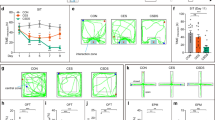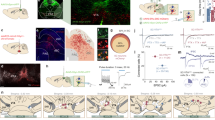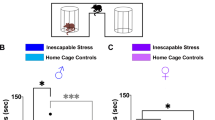Abstract
Social animals encounter both environmental and social stress, yet the mechanisms by which individuals with different levels of trait anxiety cope with these stressors, as well as the neurobiological links between trait anxiety and social cognition, remain incompletely understood. Here, male mice are classified into high-trait anxiety (HTA) and low-trait anxiety (LTA) groups based on their anxiety responses to elevated platform exposure in the open field test. Under observational learning-based vicarious social defeat stress (VSDS), HTA mice exhibit less social avoidance behavior toward CD1 aggressors than LTA mice. Fiber photometry reveals that HTA mice display higher activity of ventral tegmental area (VTA) dopaminergic (VTADA) neurons during environmental stress, while LTA mice exhibit greater VTADA neurons activity under social stress. Viral tracing identifies the connectivity of VTADA neurons and anterior cingulate cortex (ACC). Optogenetic and chemogenetic manipulations demonstrate that VTA-ACC dopaminergic circuit is necessary and sufficient for VSDS-induced social avoidance behavior in HTA and LTA mice. RNA-sequencing suggested that VTA neuroinflammatory signaling may be a key factor contributing to the difference between HTA and LTA mice. Thus, this study reveals a neural circuit mechanism for trait anxiety-related observational learning of social avoidance behavior in male mice, and provides a molecular mechanism in shaping trait anxiety.
This is a preview of subscription content, access via your institution
Access options
Subscribe to this journal
Receive 13 print issues and online access
$259.00 per year
only $19.92 per issue
Buy this article
- Purchase on SpringerLink
- Instant access to full article PDF
Prices may be subject to local taxes which are calculated during checkout





Similar content being viewed by others
Data availability
The RNA sequencing data have been deposited into China National GeneBank Database with the accession number CNP0005854. The other data that support the findings of this study are available from the corresponding author upon reasonable request.
References
McMichael AJ, Woodruff RE, Hales S. Climate change and human health: present and future risks. Lancet. 2006;367:859–69.
van Os J, Kenis G, Rutten BPF. The environment and schizophrenia. Nature. 2010;468:203–12.
Bijlsma R, Loeschcke V. Environmental stress, adaptation and evolution: an overview. J Evolut Biol. 2005;18:744–9.
Meyer-Lindenberg A, Tost H. Neural mechanisms of social risk for psychiatric disorders. Nat Neurosci. 2012;15:663–8.
Sandi C, Haller J. Stress and the social brain: behavioural effects and neurobiological mechanisms. Nat Rev Neurosci. 2015;16:290–304.
Vos T, Barber RM, Bell B, Bertozzi-Villa A, Biryukov S, Bolliger I, et al. Global, regional, and national incidence, prevalence, and years lived with disability for 301 acute and chronic diseases and injuries in 188 countries, 1990–2013: a systematic analysis for the Global Burden of Disease Study 2013. Lancet. 2015;386:743–800.
Penninx B, Pine DS, Holmes EA, Reif A. Anxiety disorders. Lancet. 2021;397:914–27.
Knowles KA, Olatunji BO. Specificity of trait anxiety in anxiety and depression: meta-analysis of the state-trait anxiety inventory. Clin Psychol Rev. 2020;82. https://doi.org/10.1016/j.cpr.2020.101928.
Saviola F, Pappaianni E, Monti A, Grecucci A, Jovicich J, De Pisapia N. Trait and state anxiety are mapped differently in the human brain. Sci Rep. 2020;10. https://doi.org/10.1038/s41598-020-68008-z.
Endler NS, Kocovski NL. State and trait anxiety revisited. J Anxiety Disord. 2001;15:231–45.
Etkin A, Klemenhagen KC, Dudman JT, Rogan MT, Hen R, Kandel ER, et al. Individual differences in trait anxiety predict the response of the basolateral amygdala to unconsciously processed fearful faces. Neuron. 2004;44:1043–55.
Wang T, Li M, Xu S, Liu BT, Wu T, Lu F, et al. Relations between trait anxiety and depression: a mediated moderation model. J Affect Disord. 2019;244:217–22.
Sandi C, Richter-Levin G. From high anxiety trait to depression: a neurocognitive hypothesis. Trends Neurosci. 2009;32:312–20.
Cohen S. Social relationships and health. Am Psychol. 2004;59:676–84.
Green MF, Horan WP, Lee J. Social cognition in schizophrenia. Nat Rev Neurosci. 2015;16:620–31.
Ozer EM. Albert Bandura (1925-2021). Am Psychol. 2022;77:483–4.
Penn DL, Sanna LJ, Roberts DL. Social cognition in schizophrenia: an overview. Schizophr Bull. 2008;34:408–11.
Apps MAJ, Rushworth MFS, Chang SWC. The anterior cingulate gyrus and social cognition: tracking the motivation of others. Neuron. 2016;90:692–707.
Bromberg-Martin ES, Matsumoto M, Hikosaka O. Dopamine in motivational control: rewarding, aversive, and alerting. Neuron. 2010;68:815–34.
Zweifel LS, Fadok JP, Argilli E, Garelick MG, Jones GL, Dickerson TMK, et al. Activation of dopamine neurons is critical for aversive conditioning and prevention of generalized anxiety. Nat Neurosci. 2011;14:620–U112.
Schultz W. Multiple dopamine functions at different time courses. Annu Rev Neurosci. 2007;30:259–88.
Chaudhury D, Walsh JJ, Friedman AK, Juarez B, Ku SM, Koo JW, et al. Rapid regulation of depression-related behaviours by control of midbrain dopamine neurons. Nature. 2013;493:532.
Walsh JJ, Friedman AK, Sun HS, Heller EA, Ku SM, Juarez B, et al. Stress and CRF gate neural activation of BDNF in the mesolimbic reward pathway. Nat Neurosci. 2014;17:27–9.
Morel C, Montgomery SE, Li L, Cuttoli RDD, Teichman EM, Juarez B, et al. Midbrain projection to the basolateral amygdala encodes anxiety-like but not depression-like behaviors. Nat Commun. 2022;13. https://doi.org/10.1038/s41467-022-29155-1.
Tye KM, Mirzabekov JJ, Warden MR, Ferenczi EA, Tsai HC, Finkelstein J, et al. Dopamine neurons modulate neural encoding and expression of depression-related behaviour. Nature. 2013;493:537.
Zalachoras I, Astori S, Meijer M, Grosse J, Zanoletti O, de Suduiraut IG, et al. Opposite effects of stress on effortful motivation in high and low anxiety are mediated by CRHR1 in the VTA. Sci Adv. 2022;8. https://doi.org/10.1126/sciadv.abj9019.
Cha J, Carlson JM, DeDora DJ, Greenberg T, Proudfit GH, Mujica-Parodi LR. Hyper-reactive human ventral tegmental area and aberrant mesocorticolimbic connectivity in overgeneralization of fear in generalized anxiety disorder. J Neurosci. 2014;34:5855–60.
Berry AS, White RL, Furman DJ, Naskolnakorn JR, Shah VD, D’Esposito M, et al. Dopaminergic mechanisms underlying normal variation in trait anxiety. J Neurosci. 2019;39:2735–44.
Comte M, Cancel A, Coull JT, Schön D, Reynaud E, Boukezzi S, et al. Effect of trait anxiety on prefrontal control mechanisms during emotional conflict. Hum Brain Mapp. 2015;36:2207–14.
Klumpp H, Ho SS, Taylor SF, Phan KL, Abelson JL, Liberzon I. Trait anxiety modulates anterior cingulate activation to threat interference. Depress Anxiety. 2011;28:194–201.
Hein TP, Gong Z, Ivanova M, Fedele T, Nikulin V, Ruiz MH. Anterior cingulate and medial prefrontal cortex oscillations underlie learning alterations in trait anxiety in humans. Commun Biol. 2023;6. https://doi.org/10.1038/s42003-023-04628-1.
Amodio DM, Frith CD. Meeting of minds: the medial frontal cortex and social cognition. Nat Rev Neurosci. 2006;7:268–77.
Shackman AJ, Salomons TV, Slagter HA, Fox AS, Winter JJ, Davidson RJ. The integration of negative affect, pain and cognitive control in the cingulate cortex. Nat Rev Neurosci. 2011;12:154–67.
Gebara E, Zanoletti O, Ghosal S, Grosse J, Schneider BL, Knott G, et al. Mitofusin-2 in the nucleus accumbens regulates anxiety and depression-like behaviors through mitochondrial and neuronal actions. Biol Psychiatry. 2021;89:1033–44.
Qi, GJ, Zhang P, Li TX, Li M, Zhang Q, He F, et al. NAc-VTA circuit underlies emotional stress-induced anxiety-like behavior in the three-chamber vicarious social defeat stress mouse model. Nat Commun. 2022;13. https://doi.org/10.1038/s41467-022-28190-2.
Jeon D, Kim S, Chetana M, Jo D, Ruley HE, Lin SY, et al. Observational fear learning involves affective pain system and Cav1.2 Ca2+ channels in ACC. Nat Neurosci. 2010;13:482–U105.
Apps MAJ, Sallet J. Social learning in the medial prefrontal cortex. Trends Cogn Sci. 2017;21:151–2.
Sial OK, Warren BL, Alcantara LF, Parise EM, Bolaños-Guzmán CA. Vicarious social defeat stress: Bridging the gap between physical and emotional stress. J Neurosci Methods. 2016;258:94–103.
Warren BL, Vialou VF, Iñiguez SD, Alcantara LF, Wright KN, Feng J, et al. Neurobiological sequelae of witnessing stressful events in adult mice. Biol Psychiatry. 2013;73:7–14.
Gallese V, Keysers C, Rizzolatti G. A unifying view of the basis of social cognition. Trends Cogn Sci. 2004;8:396–403.
Boehme S, Miltner WHR, Straube T. Neural correlates of self-focused attention in social anxiety. Soc Cogn Affect Neurosci. 2015;10:856–62.
Bar-Haim Y, Lamy D, Pergamin L, Bakermans-Kranenburg MJ, van Ijzendoorn MH. Threat-related attentional bias in anxious and nonanxious individuals: a meta-analytic study. Psychol Bull. 2007;133:1–24.
Ho SMY, Yeung D, Mak CWY. The interaction effect of attentional bias and attentional control on dispositional anxiety among adolescents. Br J Psychol. 2017;108:564–82.
Jeon D, Kim S, Chetana M, Jo D, Ruley HE, Lin SY, et al. Observational fear learning involves affective pain system and Cav1.2 Ca2+ channels in ACC. Nat Neurosci. 2010;13:482–8.
Klein MO, Battagello DS, Cardoso AR, Hauser DN, Bittencourt JC, Correa RG. Dopamine: functions, signaling, and association with neurological diseases. Cell Mol Neurobiol. 2019;39:31–59.
Edwards NJ, Tejeda HA, Pignatelli M, Zhang SL, McDevitt RA, Wu J, et al. Circuit specificity in the inhibitory architecture of the VTA regulates cocaine-induced behavior. Nat Neurosci. 2017;20:438–48.
Abdul M, Yan HQ, Zhao WN, Lyu XB, Xu Z, Yu XL, et al. VTA-NAc glutaminergic projection involves in the regulation of pain and pain-related anxiety. Front Mol Neurosci. 2022;15. https://doi.org/10.3389/fnmol.2022.1083671.
Mar RA. The neural bases of social cognition and story comprehension. In: Fiske ST, Schacter DL, Taylor SE, editors. Annual review of psychology, Vol. 622011. p. 103–34.
Singer T, Seymour B, O’Doherty J, Kaube H, Dolan RJ, Frith CD. Empathy for pain involves the affective but not sensory components of pain. Science. 2004;303:1157–62.
Morrison I, Lloyd D, di Pellegrino G, Roberts N. Vicarious responses to pain in anterior cingulate cortex: Is empathy a multisensory issue? Cogn Affect Behav Neurosci. 2004;4:270–8.
Morrison I, Downing PE. Organization of felt and seen pain responses in anterior cingulate cortex. Neuroimage. 2007;37:642–51.
Song Q, Wei A, Xu H, Gu Y, Jiang Y, Dong N, et al. An ACC-VTA-ACC positive-feedback loop mediates the persistence of neuropathic pain and emotional consequences. Nat Neurosci. 2024;27:272–85.
Elston TW, Croy E, Bilkey DK. Communication between the anterior cingulate cortex and ventral tegmental area during a cost-benefit reversal task. Cell Rep. 2019;26:2353.
Elston TW, Bilkey DK. Anterior cingulate cortex modulation of the ventral tegmental area in an effort task. Cell Rep. 2017;19:2220–30.
Song Q, Wei AQ, Xu HD, Gu YH, Jiang Y, Dong N, et al. An ACC-VTA-ACC positive-feedback loop mediates the persistence of neuropathic pain and emotional consequences. Nat Neurosci. 2024. https://doi.org/10.1038/s41593-023-01519-w.
Michopoulos V, Powers A, Gillespie CF, Ressler KJ, Jovanovic T. Inflammation in Fear- and Anxiety-Based Disorders: PTSD, GAD, and Beyond. Neuropsychopharmacology. 2017;42:254–70.
Radtke FA, Chapman G, Hall J, Syed YA. Modulating neuroinflammation to treat neuropsychiatric disorders. Biomed Res Int. 2017;2017. https://doi.org/10.1155/2017/5071786.
Sah A, Rooney S, Kharitonova M, Sartori SB, Wolf SA, Singewald N. Enriched environment attenuates enhanced trait anxiety in association with normalization of aberrant neuro-inflammatory events. Int J Mol Sci. 2022;23. https://doi.org/10.3390/ijms232113052.
Escos A, Diaz-Mora E, Pattison M, Fajardo P, Gonzalez-Romero D, Risco A, et al. p38gamma and p38delta modulate innate immune response by regulating MEF2D activation. Elife. 2023;12. https://doi.org/10.7554/eLife.86200.
O’Neill LAJ, Golenbock D, Bowie AG. The history of Toll-like receptors - redefining innate immunity. Nat Rev Immunol. 2013;13:453–60.
Nie X, Kitaoka S, Tanaka K, Segi-Nishida E, Imoto Y, Ogawa A, et al. The innate immune receptors TLR2/4 mediate repeated social defeat stress-induced social avoidance through prefrontal microglial activation. Neuron. 2018;99:464.
Funding
This work was supported financially by grants from the National Natural Science Foundation of China (nos. 31871073 and 32171023 to BT; nos. 32271036 and 32471034 to PZ).
Author information
Authors and Affiliations
Contributions
ML contributed to investigation, conducting experiments, acquiring data, analyzing data, reviewing the manuscript, visualization and all the manuscript revision work. KR contributed to conceptualization, experimental design, conducting experiments, acquiring data, analyzing data, writing the manuscript, and visualization. CC, Y-LS, and JL contributed to animal surgeries and in vivo analyses. T-XL and JY contributed to investigation and validation. XP and X-KY contributed to methodology. Y-BY and G-GL contributed to data curation. J-SD and S-TC contributed to behavior tests. PZ and BT contributed to conceptualization, methodology, resources, writing – review & editing, visualization, supervision, project administration, and funding acquisition.
Corresponding authors
Ethics declarations
Competing interests
The authors declare no competing interests.
Additional information
Publisher’s note Springer Nature remains neutral with regard to jurisdictional claims in published maps and institutional affiliations.
Supplementary information
Rights and permissions
Springer Nature or its licensor (e.g. a society or other partner) holds exclusive rights to this article under a publishing agreement with the author(s) or other rightsholder(s); author self-archiving of the accepted manuscript version of this article is solely governed by the terms of such publishing agreement and applicable law.
About this article
Cite this article
Li, M., Ren, K., Cui, C. et al. VTA-ACC dopaminergic circuit mediates trait anxiety-related observational learning of social avoidance in male mice. Neuropsychopharmacol. 50, 1364–1375 (2025). https://doi.org/10.1038/s41386-025-02139-7
Received:
Revised:
Accepted:
Published:
Issue date:
DOI: https://doi.org/10.1038/s41386-025-02139-7



